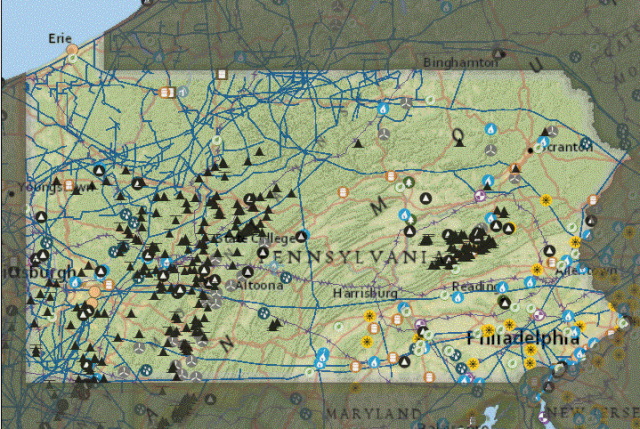Green Watch
The “Greening” of Pennsylvania: Energy Powerhouse of the East
 Pennsylvania energy production. Source: U.S. Energy Information Agency.
Pennsylvania energy production. Source: U.S. Energy Information Agency.

Exposing the Eco-Activists’ “Greening” of Pennsylvania in 2020 (full series)
Energy Powerhouse of the East | Cap-and-Trade Explained
The War on Fracking | Enter Activism Inc.
Summary: The Keystone State, an oil and natural gas powerhouse, is under siege by an alliance of well-organized, well-funded “green” activists. From cap-and-trade schemes meant to bleed ratepayers dry to fracking bans on one of Pennsylvania’s most vital industries, the environmental Left is fighting an all-out war to blanket the commonwealth with its antihuman ideology. If successful, the activists will transform one of the country’s most important energy-producing states into the professional Left’s latest conquest—and Pennsylvanians will pay the price.
Pennsylvania is the largest net exporter of electricity in the U.S., and its great success has made it a target of professional left-wing activists. These environmentalists are waging a nationwide war on cheap, abundant energy from coal, oil, and natural gas. They want to force the country to arbitrarily shift to unreliable and expensive sources such as wind turbines and solar plants.
Energy Powerhouse of the East
If any state understands oil, coal, and gas, it’s Pennsylvania. America’s oil industry—and its first oil boom—started in Titusville in 1859. Drillers and investors such as John D. Rockefeller and his Standard Oil flocked to the commonwealth, turning backwater towns into thriving metropolises. At its peak, Pennsylvania was producing one-third of the world’s annual oil output, driving the construction of railroads and the rise of American manufacturing well into the 20th century.
More than a century after its golden age ended, Pennsylvania is again the energy powerhouse of the East. According to the U.S. Energy Information Administration, the Keystone State is the nation’s second-largest producer of natural gas, third-largest producer of coal, 16th-largest producer of crude oil, and third-largest producer of electricity in general.
Pennsylvania is also the largest net exporter of electricity in the U.S., delivering an average of 58 million megawatt-hours annually between 2013 and 2017. Pennsylvanians enjoy electricity prices below the national average—largely thanks to the fracking boom of the mid-2000s, which reinvigorated the state’s natural gas industry and helped much of western Pennsylvania stave off the worst effects of the Great Recession.
But all of that could change in an instant.
Pennsylvania’s great success has made it a target of professional left-wing activists who subscribe to a rigid ideology that demonizes carbon dioxide—a naturally occurring gas vital to life on earth. These environmentalists are waging a nationwide war on cheap, abundant energy from coal, oil, and natural gas, forcing the country to arbitrarily shift to unreliable and expensive sources such as wind turbines and solar plants.
With backing from ultraliberal foundations and mega-donors, they’ve made huge gains in the Northeast, instituting a cap-and-trade system (the Regional Greenhouse Gas Initiative) designed to snuff out traditional energy sources in favor of those of the activists’ choosing. Many are lobbying for a statewide ban on fracking, which would cost Pennsylvania hundreds of thousands of jobs and spike household electricity prices. It’s a war that the Keystone State can’t afford to lose.
The Regional Greenhouse Gas Initiative
The Regional Greenhouse Gas Initiative (RGGI; pronounced “Reggie”) is a multistate cap-and-trade system created in 2009. RGGI is a carbon pricing program—that is, it aims to reduce emissions of carbon dioxide (the leading “greenhouse gas”) to offset future effects of global warming on the planet by taxing it into oblivion. As famed economist Milton Friedman would put it: “If we tax something, we get less of it.”
Eleven states—Maine, Connecticut, Massachusetts, New Hampshire, Rhode Island, Vermont, New York, New Jersey, Delaware, Maryland, and Virginia—are signatories. Virginia, the most recent addition, is scheduled to join RGGI in January 2021.
Naturally, proponents are pressuring Pennsylvania, the second-largest energy producer in the U.S. and a neighbor to the RGGI bloc, to join the compact. In October 2019, Governor Tom Wolf (D) issued an executive order instructing the Pennsylvania Department of Environmental Protection (DEP) to begin formulating regulations for eventually joining RGGI. The agency moved to develop a plan for regulating greenhouse gas emissions under RGGI by September 15, 2020.
Whether Wolf has the authority to join the compact is a heated question.
Environmentalist groups such as the Natural Resources Defense Council (NRDC) argue that he does, under Pennsylvania’s Air Pollution Control Act (which authorizes the DEP to regulate carbon dioxide emissions from power plants) and the state’s constitution (which requires that the agency regulate “climate pollution”).
But some legal experts disagree. Joining RGGI requires the state to sign RGGI’s memorandum of understanding, the contract controlling the multistate operation, but the Pennsylvania constitution delegates the power to enter into interstate agreements to the Pennsylvania General Assembly, not the governor. Further, the DEP is authorized to “formulate interstate air pollution control compacts”—not execute them—“for the submission thereof to the General Assembly” for consideration.
Republicans in the state legislature largely agree. In June 2020, the House Committee on Environmental Resources and Energy voted 16–8 to advance a measure blocking Pennsylvania from entering RGGI (HB 2025), almost entirely along partisan lines (one Democrat, Representative Pam Snyder, supported the bill).
In July, the Pennsylvania House of Representatives passed the bill, which was cosponsored by seven Democrats, by 130–71—six votes shy of a veto-proof majority. In early September, the bill passed the Pennsylvania Senate, with bipartisan support, by 33–17, one vote shy of a veto-proof majority. Governor Wolf vetoed the bill on September 24, 2020.
In the next installment of “The ‘Greening’ of Pennsylvania,” learn how cap-and-trade really works.
This article first appeared in RealClearEnergy on October 14, 2020.



